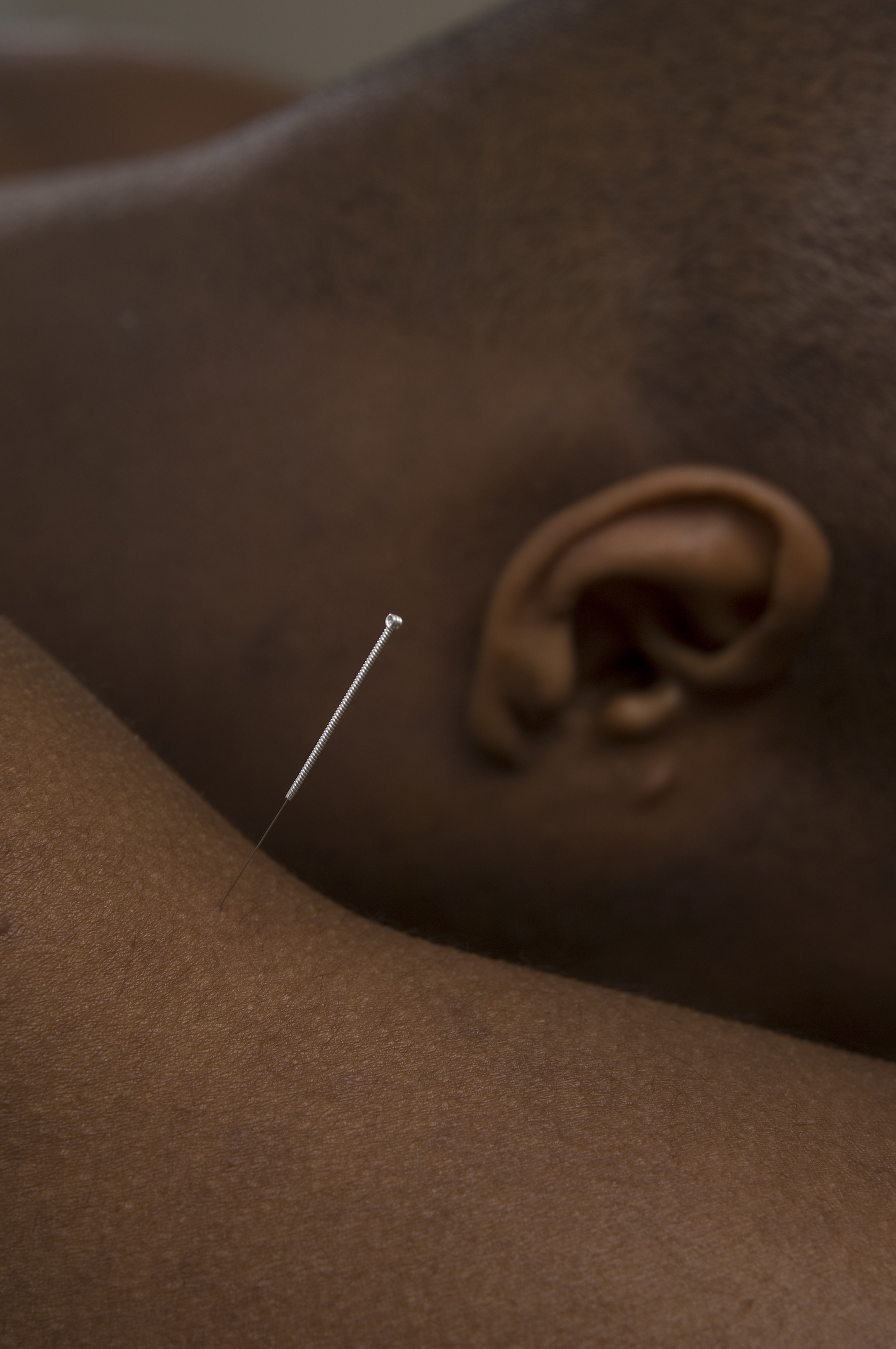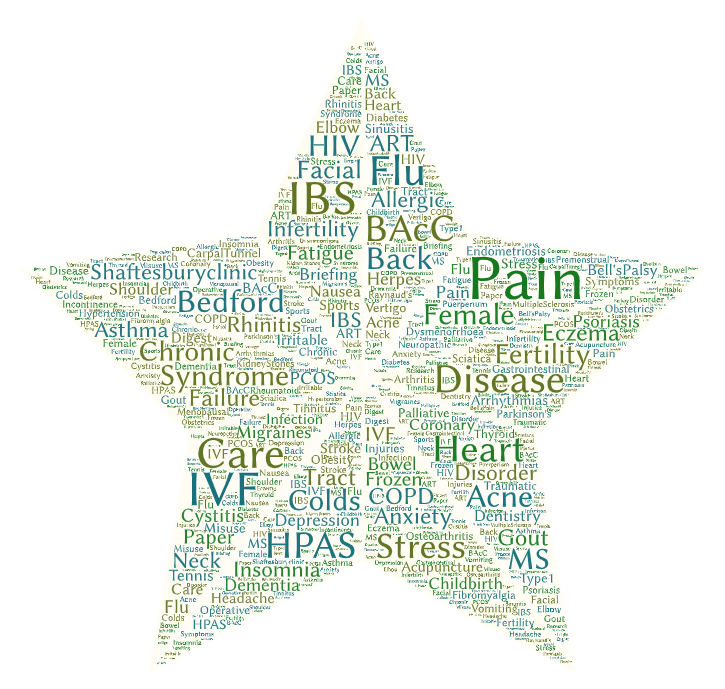Important to know: Chronic health conditions should be addressed under direct medical supervision of your GP or consultant, and acupuncture would be an adjunct or complement to usual care – we advise that you let you doctor know when you use this approach.
Battlefield acupuncture was developed with the intention to be used in military battlefields as well as in emergency situations, as a protocol for the rapid relief of pain. Consisting of a set of auricular acupuncture points (on the ear), the technique is tailored to the type and location of the pain, making it potentially applicable to many types of pain.
Case Study and Video for Trauma/PTSD
Acupuncturists (MBAcC) Rachel Peckham and Samina Haider set up an acupuncture NADA group in a Mosque in London in the aftermath of the Grenfell Tower tragedy, using the NADA protocol for trauma application, there is a video about this from the British Acupuncture Council here that may be of interest, and which shows the NADA protocol in action, and patients talking about it and their experiences of it: BAcC auricular (NADA) video Rachel talks about the general uses of this, background and the idea which came from the use of this in the aftermath of 9/11 in America.
Research and Resources on Battlefield Acupuncture:
A scholarly search of the available research papers on the terms “acupuncture” + “battlefield” yields over 3150 papers, and narrowing this to “RCT” to identify Randomised Controlled Trials, gives over 139 results; of which 48% have been carried out since 2017 (Google Scholar). This suggests that acupuncture is being used currently in this area, leading to a small body of research being carried out so far (it is a recent development and area of practise). However the pace of research is increasing with nearly 50% of the research ever done, having happened in the last 4 years, showing promise for future studies and systematic reviews regarding examining its potential role.
Interpreting the research:
When reading health research, it is important to know that Systematic Reviews or Meta Analyses of a large number of high-quality research studies are the very best way to be able to say to what extent a given treatment can address a condition, symptom, or set of symptoms. The next best level of evidence is the individual Randomised Controlled Study (RCT) which uses a systematic technique to compare two or more groups of patients receiving different treatments (or a treatment against a “control”, or no treatment). In acupuncture trials, the nature of the control group is of particular interest as it is hard to blind a patient to whether they are having a needle inserted or not, and even more challenging to blind the researcher/team to this.
The means and quality of how research is carried out varies considerably from country to country, and in terms of how an intervention is compared to another intervention (or a control). Of note is the fact that “sham” acupuncture (where needles are placed in apparently inert locations rather than traditional acupuncture points) is not really an inert process as it has physiological effects, so that comparing sham and “true acupuncture” may therefore not give a clear picture alone; but and form a part of a research body where acupuncture versus no treatment, vs conventional treatment or vs a different approach/modality also form part of the evidence base.
The n= figure (where quoted in research) tells you how many people were participants in the study, and usually the larger a study (when it is of good quality and design), the more likely it is to be reliable and applicable to larger populations. When (statistical) “significance” is discussed in view of studies it has a very particular meaning – it is the confidence in the data (using statistical tests) that tells us how likely a result could have just come about by chance. The lower the possibility of a chance result, the more likely it is due to the intervention in the experiment. When you are reading a trial/study, the “p” is the number telling us of significance, and this must be under 5% (or p less than 0.05) to mean we can say it is a (statistically) “significant” result.
The Research:
A 2017 systematic review of 6 trials (Jan et al, 2017; n=458) found that “ear acupuncture, either as stand-alone or as-an-adjunct technique, significantly reduced pain scores and has potential benefits for use in the ED [emergency department]”, although study numbers were limited at the time more research had since been carried out, so we look forward to more sysyematic reviews as this develops..
This style of acupuncture has been found effective as an adjunct for low back pain in a USA ED setting (Emergency Dept., A&E equivalent, with a statistically significant benefit over usual care alone (Fox et al, 2018; n=30; p=0.04). Tsai et al, (2016) described 4 cases in which emergency physicians with brief training in the protocol treated patients with acute pain when opioid-based painkillers were unsuitable. It has also been examined in the case of chronic neck pain (Guthrie et al, 2016).
Elsewhere, battlefield acupuncture is used the US Department of Defense’s medical facilities for ex-military personnel for trauma related issues including PTSD (Walker et al, 2016);
Recently, a systematic review protocol was put forward (Zhang et al, 2020) for application of battlefield acupuncture protocol to migraine; it will be interesting to see the outcome here.
Regarding Your Individual Condition and Symptoms:
There are many painful conditions for which patients seek out acupuncture to address their symptoms. We have dedicated pages for arthritis, back pain, carpal tunnel, facial (TMJ) pain, shoulder and frozen shoulder, headache, migraine, kidney stones, plantar fasciitis, knee pain, sciatica, neuropathic (nerve) pain, rheumatoid arthritis, tennis and golfer’s elbow, neck pain, and pelvic pain each of which give references and further resources to evidence based factsheets and may be of use.
Whilst the scientific studies are of great interest to researchers and acupuncturists in terms of comparing protocols, for the patient not versed in research they are less accessible, which is why when we asked “can acupuncture work for my (condition or symptom) we are not able to give a simple yes or no response. We are able to tell you what experience we have had in our decades of experience in practise, of the types of outcomes we have seen in similar cases, and give you an idea of our level of experience and knowledge in that area, and how this could relate to your own individual situation. For this, we recommend booking a free telephone consultation where we can answer any questions you have and give a realistic appraisal of what acupuncture may be able to provide.
References:
Fox, L.M., Murakami, M., Danesh, H. and Manini, A.F., 2018. Battlefield acupuncture to treat low back pain in the emergency department. The American Journal of Emergency Medicine, 36(6), pp.1045-1048.
Guthrie, R.M. and Chorba, R., 2016. Physical Therapy Treatment Of Chronic Neck Pain A Discussion And Case Study: Using Dry Needling And Battlefield Acupuncture. Journal of special operations medicine: a peer reviewed journal for SOF medical professionals, 16(1), pp.1-5.
Jan, A.L., Aldridge, E.S., Rogers, I.R., Visser, E.J., Bulsara, M.K. and Niemtzow, R.C., 2017. Does ear acupuncture have a role for pain relief in the emergency setting? A systematic review and meta-analysis. Medical acupuncture, 29(5), pp.276-289.
Niemtzow, R.C., 2007. Battlefield acupuncture. Medical Acupuncture, 19(4), pp.225-228.
Tsai, S.L., Fox, L.M., Murakami, M. and Tsung, J.W., 2016. Auricular acupuncture in emergency department treatment of acute pain. Annals of emergency medicine, 68(5), pp.583-585.
Walker, P.H., Pock, A., Ling, C.G., Kwon, K.N. and Vaughan, M., 2016. Battlefield acupuncture: opening the door for acupuncture in Department of Defense/Veteran’s Administration health care. Nursing outlook, 64(5), pp.491-498.
Zhang, F., Shen, Y., Fu, H., Zhou, H. and Wang, C., 2020. Auricular acupuncture for migraine: a systematic review protocol. Medicine, 99(5).



